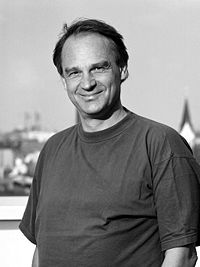Gerd Binnig Scientist
Gerd Binnig (born 20 July 1947) is a German physicist, who won the Nobel Prize in Physics in 1986 for the invention of the scanning tunneling microscope.He was born in Frankfurt am Main and played in the ruins of the city during his childhood. His family lived partly in Frankfurt and partly in Offenbach am Main, and he attended school in both cities. At the age of 10, he decided to become a physicist, but he soon wondered whether he had made the right choice. He concentrated more on music, playing in a band. He also started playing the violin at 15 and played in his school orchestra.Binnig studied physics at the J.W. Goethe University in Frankfurt, gaining a bachelor's degree in 1973 and remaining there do a PhD with in Werner Martienssen's group, supervised by Eckhardt Hoenig.In 1969, he married Lore Wagler, a psychologist, and they have a daughter born in Switzerland and a son born in California. His hobbies are reading, swimming and golf.In 1978, he accepted an offer from IBM to join their Zürich research group, where he worked with Heinrich Rohrer, Christoph Gerber and Edmund Weibel. There they developed the scanning tunneling microscope (STM), an instrument for imaging surfaces at the atomic level.The Nobel committee described the effect that the invention of the STM had on science, saying that "entirely new fields are opening up for the study of the structure of matter." The physical principles on which the STM was based were already known before the IBM team developed the STM, but Binnig and his colleagues were the first to solve the significant experimental challenges involved in putting it into effect.The IBM Zürich team were soon recognized with a number of prizes: the German Physics Prize, the Otto Klung Prize, the Hewlett Packard Prize and the King Faisal Prize. In 1986, Binnig and Rohrer shared half of the Nobel Prize in Physics, the other half of the Prize was awarded to Ernst Ruska.Binnig, Gerber and Calvin Quate went on to develop the atomic force microscope (AFM).In 1987 Binnig was appointed IBM Fellow.In 1994 Professor Gerd Binnig founded Definiens which turned in the year 2000 into a commercial enterprise. Today, companies and institutions around the world use Definiens' technology to maximize the value of images and thereby enabling better decisions. Definiens currently focuses on applications for Life Sciences and Earth Sciences. In Life Sciences, Definiens' technology is used to accelerate the drug discovery, development, and diagnostics processes. In Earth Sciences, Definiens' technology enables satellite and aerial image classification and analysis with greater speed, accuracy and insight.The Binnig and Rohrer Nanotechnology Center, an IBM-owned research facility in Rüschlikon, Zurich is named after Gerd Binnig and Heinrich Rohrer.
